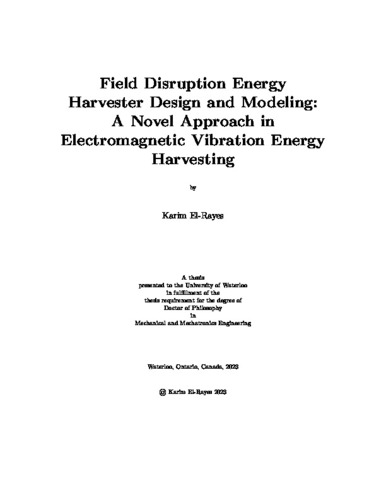| dc.description.abstract | The demand for sustainable and non-traditional sources of energy increases every day to power up different electronic equipment whether it's portable low-power devices, non-accessible sensors, wearable electronics, implantable medical devices, and even for big scale applications that can contribute to the energy demand on a public level. Energy harvesting from vibrations offers an ideal source of energy, since it's renewable and prevailing, where kinetic energy that can be harvested is abundant in nature. \newline
In this proposal, a novel electromagnetic transduction mechanism is introduced that can be used in harvesting low-frequency vibrations below 10 Hz, which makes it suitable to harvest motion from human locomotion, moving vehicles, and structures like buildings, bridges and streets. The transduction mechanism developed induces a current in a coil by disrupting the electromagnetic field in the vicinity of a stationary coil wound around a hollow track (tube) made of non-conducting or conducting (copper) material, where a ball made of ferromagnetic material is moving freely along the track cutting the field lines and induces current in the coil.
Prototypes embodying the harvesting mechanism were fabricated and tested to identify the different system parameters, frequency-responses and characterize the harvester in order to derive a representative mathematical model. The performance of the energy harvester was measured and characterized in terms of output power, power density and tunability. Where the prototypes fabricated demonstrated a capability to harvest energy at low-frequencies in the range of 6.54-12.72 Hz , with a 3 dB harvesting bandwidth ranging between 1.32 Hz to 5.8 Hz, and generated output power up to 154 micro-Watt.
The proposed transduction mechanism demonstrated a strong flexibility that allows tuning the center frequency magnetically, without the need to modify the mechanical design, in order to take advantage of this feature, an intelligent fuzzy tuner design is proposed, supported with simulation results that show the potential of adaptive control of center frequency to increase the generated output power. \newline
This abstract proposes a future plan for the development of the intelligent fuzzy tuner hardware and it's validation to increase the generated output power and power density at low frequencies while reducing the need for any external interference in the harvester's operation, leading the way for a new generation of adaptive vibrations-based energy harvesters. | en |

